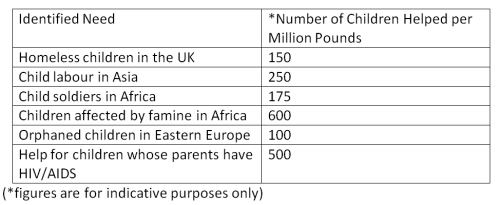You’ll have a red nose soon and it won’t be just because of the cold – it’ll soon be Red Nose Day, aka Comic Relief and the numbers will be crunching telling us how well we’ve been doing raising money to help children around the world.

This year is very special for it’s the 25th Red Nose Day and the celebrations and fund raising drives are going to be keener than ever. Usually schools take their feet off the pedals a little to allow children to enjoy the fun or to carry out fund raising activities of their own. If you want to get a little work done in the maths lesson that day but still involve Comic Relief, try these activities and the English activities that accompany them.
Activity One – Allocating Money
Year 3 to Year 6
This activity enables children think about how a number can be split using fractions or percentages and allows them to make decisions based on their concerns for others.
LO:
Be able to use fractions and percentages to divide up a sum of money and allocate it based on personal beliefs.
Be able to calculate sums involving large numbers using a calculator
Talking Point:
Each year Comic Relief raises tens of millions of pounds, all of which is spent on helping children around the world. Expenses are paid by sponsors from the interest earned on money in the bank waiting to be used.
Ask the children to say what kind of children are helped by donations to Comic Relief and can they suggest any others.
Should all the money be given to one type of need or should it be spread around, one country or region or several. There is often controversy over the amount that is spent in foreign countries instead of on suffering children in the UK. What are their views on that?
Activity:
In 2011, almost £75m was pledged or donated during the day of Comic Relief and over £100m in total. Using the total figure of £100m ask the children to decide which of the following causes would be most deserving of receiving some of the money.
How many children in each category could be helped if the money was spent purely on them?
Talking Point:
Ask them whether this is a fair way of spending the money. How else would they apportion it and ask on what basis they are making their decisions.
Ask them to calculate how much they would spend as a fraction or percentage of the £100m on each cause and calculate how many children would be helped in each scenario. How many children would be helped overall? They should write notes for each justifying their decisions.
Talking Point:
Should the decision be made just on how many can be helped or are there other criteria that can be used? Ask them to reconsider their decisions and calculations based on the class discussion.
At Home:
Get the children to research projects that have been funded by Comic Relief in the past. How much was spent, what was it spent on, and how successful was it in terms of numbers helped?
Activity Two – Scale: How Many Times?
Year 3 to Year 6
In their daily lives children often encounter large numbers that seem abstract in isolation. This activity enables the children to compare large numbers by scale. E.g. England is ten times bigger than…, there are a hundred times more starving people in Africa than… etc.
LO:
Use ‘times bigger’ to compare the size of numbers, measures etc.
Use pictures to compare size.
Talking Point:
Ask the children to say how many times taller they think their teacher is than them. How many times heavier is the teacher than they are?
Activity:
Start off writing pairs of numbers on the board e.g. 4 and 32. Ask the children to say how much bigger 32 is than 4. You are likely to get the answers either 28 (difference) or 8 times (multiplier). Use further pairs of numbers and ask the same question. Ask the children which they think gives them the better idea of comparable size.
Use the worksheet that accompanies this activity and ask the children to measure the differences in length, width or height of the first few examples then calculate the number of times greater each measurement is (to the nearest whole number). Does ‘five times bigger’, give a more accurate comparison than say ‘4cm bigger’?
Back to Comic Relief now and the accompanying sheet gives children practice on calculating how many times bigger numbers are using the receipts from Comic Relief over the last 25 years.
At Home:
Ask the children to compare things such as size of food packages, length of gardens, speed limits etc. by using ‘times bigger’
Dave Lewis, Primary Teacher
You can find ideas on how to celebrate Red Nose Day in your literacy lessons here…




